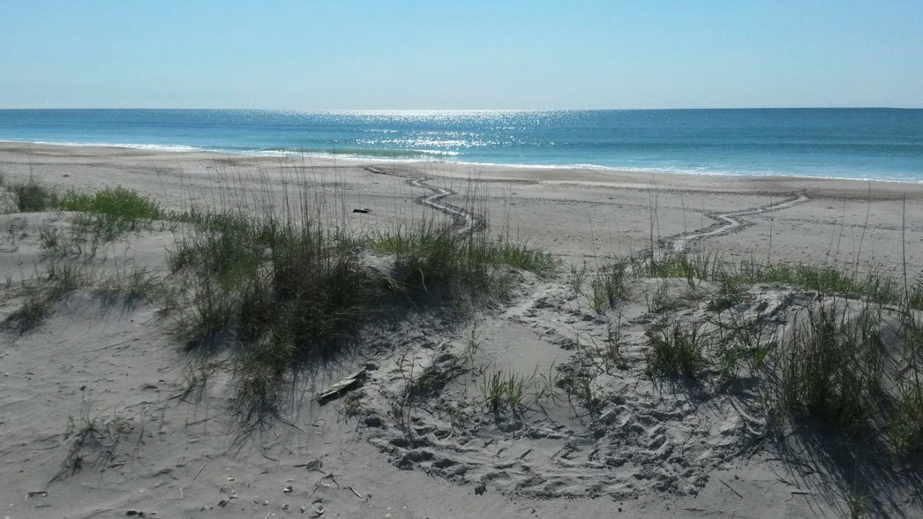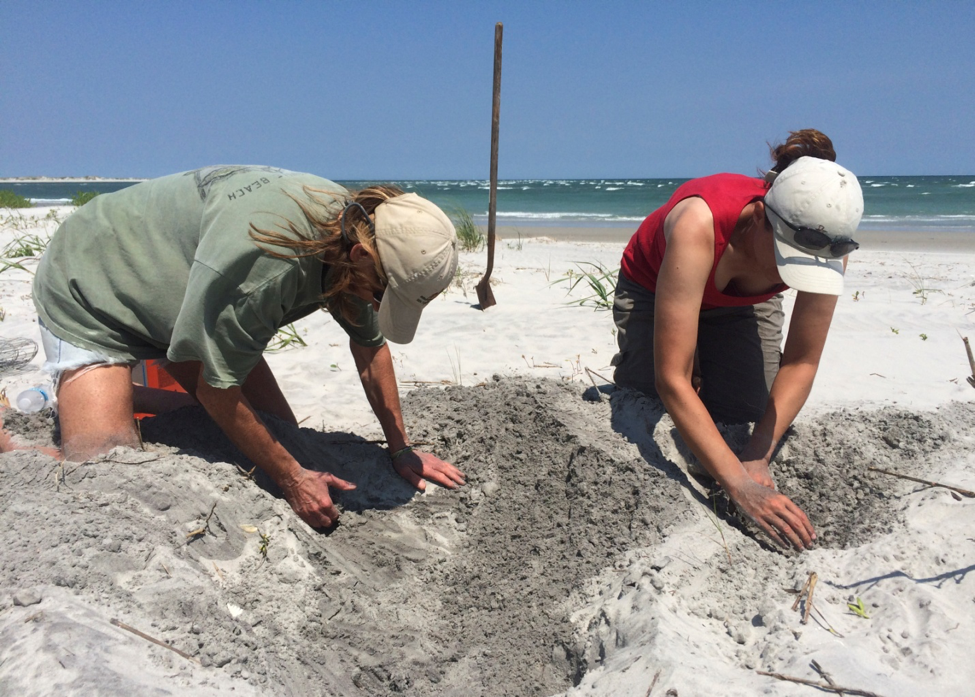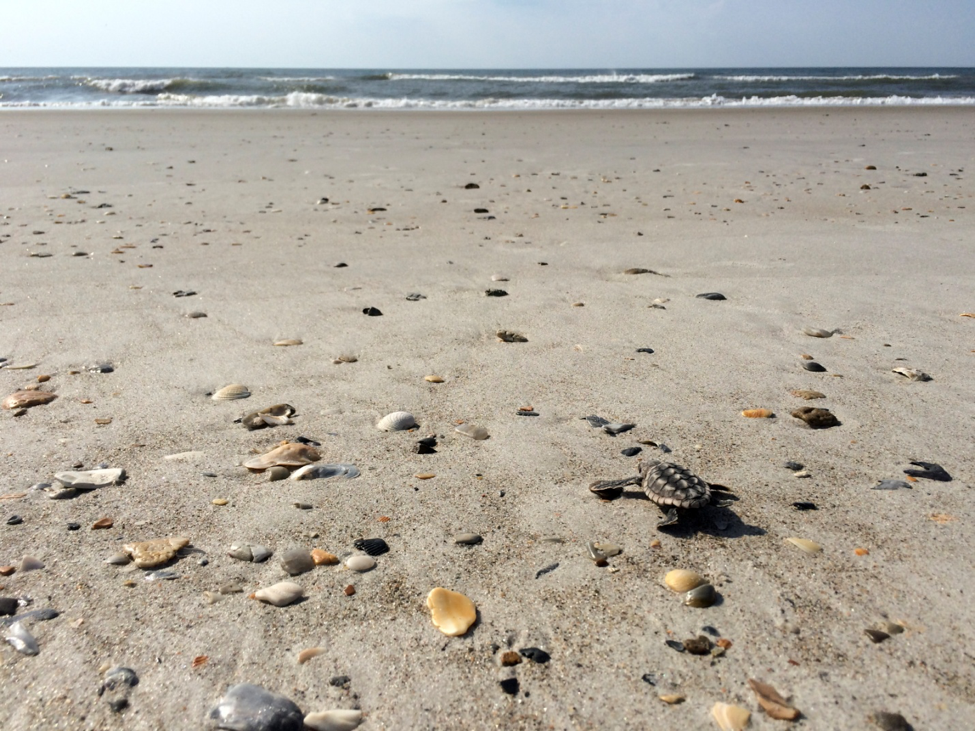Although much of the work Audubon North Carolina does on Lea-Hutaff Island revolves around birds, we also monitor sea turtle nesting and mange nests to protect them from predators.
Though four species of sea turtle have been recorded nesting in North Carolina, the vast majority of nesting in the state is from loggerhead sea turtles, and to date, they are the only species recorded nesting on Lea-Hutaff Island. Loggerheads were listed as federally threatened in 1978, and Audubon joins many other organizations, including volunteer groups in many beach towns, to monitor nesting across the North Carolina coast and report data to the NC Wildlife Resources Commission, which coordinates sea turtle monitoring in the state.
About Loggerhead Sea Turtles
Loggerheads—which do have large, broad heads as their name implies—can weigh over 400 pounds and take about 30 years to mature from a tiny hatchling to an adult able to reproduce. Unlike most birds, which lay relatively few eggs and invest a lot of time in caring for their chicks, sea turtles lay many eggs and, beyond digging a nest to deposit their eggs in, do not care for their hatchlings. Nesting females usually crawl up onto a beach after dark, dig a nest above the high tide line, and lay about 120 eggs. Females don’t nest every year, but in nesting years, they usually nest three to four times.
The eggs take about 60 days to incubate. Unlike birds and mammals, the sex of the hatchlings is not determined when the eggs are fertilized. Instead, warmer temperatures in the nest (about 89 degrees Fahrenheit or above) make females and cooler temperatures make males. Since it’s near the northern extent of their breeding range, North Carolina probably contributes more males to the population than states to the south.
Hatchlings emerge after dark, climbing their way out of the nest through about two feet of sand and scramble down the beach. They are first guided by light, since on undeveloped beaches moon- or starlight reflecting off the ocean is the brightest thing visible. Once they are in the water, they swim into the waves and some hours later, begin to navigate using the Earth’s magnetic field.

Monitoring Coastal Habitats
On Lea-Hutaff Island we monitor loggerhead nesting activity by looking for the unmistakable tracks nesting females leave behind in the sand. This year, seasonal biological technician Jen Carman found the first sea turtle activity on May 23. This is typical for Lea-Hutaff, where we often locate the first sea turtle nest around Memorial Day. That first crawl was a false crawl—the female emerged but didn’t dig a nest—and then three days later, Jen found the first nest. The last nest was found on July 20.

Over the summer, we found nine loggerhead nests on Lea-Hutaff. Each nest was protected from predation by raccoons or other mammalian predators by a metal cage placed over the nest to prevent anything from digging in. The gaps in the wire mesh are large enough that hatchlings can crawl out through them. After each nest hatches or reaches the end of its incubation period, we dig it up to count hatched and unhatched eggs so we can record nest success. Sometimes, a few hatchlings are still in the egg chamber, waiting to emerge.
Conservation Research
Thanks to an innovative genetics project, we’re also learning about the female sea turtles that nest on Lea-Hutaff, in North Carolina, and throughout the southeast Atlantic.
Researchers at the University of Georgia are working in North Carolina, South Carolina, and Georgia to take a DNA sample from each nest laid on the states’ beaches. The mother sea turtle’s DNA is found on the membrane lining the inside of the eggshells, and this allows each nesting female to be identified. With this information, the project will answer important questions that will aid in sea turtle conservation, including the size of the nesting population, the average interval (both within the same year and between years) at which females nest, and how close together (or far apart) do females lay their nests. By inferring mother-daughter relationships through their DNA, the study can even investigate how accurately daughters return to their hatching beaches as nesting adults.
So far, since Audubon North Carolina began collecting samples for the project in 2012, 36 DNA samples have been taken and identified to 18 individuals. In 2016, so far five DNA samples have been assigned to three unique females. Though Lea-Hutaff Island has just a fraction of the sea turtle nests in the state, large-scale projects like this can make big contributions to science and conservation and require the participation and teamwork of many organizations.

From 2016’s nine nests, 1,019 eggs were laid. Unfortunately, it appeared that one female which nested three times this year was laying “dud” eggs that never hatched. However, thanks to the DNA study, we know that in previous years, her nests had no problems and hatched most of their eggs. The other 2016 nests on Lea-Hutaff Island all did very well. No predators were able to get at the eggs, and none of the nests were washed out by storms. Overall, of those 1,019 eggs, 612 hatchlings made it to the ocean.
If some of them are very lucky, in 30 years they’ll be back on Lea-Hutaff Island nesting like their mothers and grandmothers before them.
We thank Matthew Godfrey, NCWRC sea turtle biologist, and Brian Shamblin, UGA research scientist, for allowing us to share some of the DNA study’s results.
Click here to learn more about the Coastal Sanctuaries managed by Audubon North Carolina.



